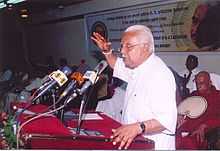Sarvodaya Shramadana Movement

The Sarvodaya Shramadana Movement is a self-governance movement in Sri Lanka, which provides comprehensive development and conflict resolution programs to villages. It is also the largest indigenous organization working in reconstruction from the tsunami caused by the 2004 Indian Ocean earthquake. Founded in 1958 by Dr A. T. Ariyaratne when he took, “forty high school students and twelve teachers from Nalanda College Colombo on “an educational experiment” to an outcaste village Kathaluwa and helped the villagers fix it up. It is based on Buddhist and Gandhian principles, including sarvodaya from which it got the name and swaraj (self-governance). The word "shramadana" means "a gift of labor".[1]
As of 2006, Sarvodaya staff people and programs are active in some 15,000 (of 38,000) villages in Sri Lanka. The organization estimates that 11 million citizens are individual beneficiaries of one of their programs. The group distributes funds from a financial reserve bank of 1.6 billion rupees.[1]
Program
The Sarvodaya program begins with an invitation from a village for discussion of what is needed and how it can be done. It proceeds in stages through creating a village council, building a school and clinic, setting up family programs, creating economic opportunity so that the village economy becomes self-sustaining, starting a village bank, and offering help to other villages. In addition, Sarvodaya sponsors public meditations in which tens and sometimes hundreds of thousands of Buddhists, Hindus, Muslims and Christians meditate together on each other's welfare, using the Buddhist Brahmavihara (sublime attitude) meditations, which are acceptable within all faiths.
Fusion – Sarvodaya ICT4D Movement is the ICT for development (ICT4D) program. As a response to the emerging digital divide issues of rural Sri Lanka, Sarvodaya started setting up telecentres experimentally in 1997. This has led to the pioneering telecentre program in the country. Village Information Centres (popularly known as VICs) are rural libraries, set up by village youth leaders as 'Zero Cost' village initiatives, which prepare disadvantaged, less educated rural communities for the information age. Out of the 172 VICs initiated since early 2000, there are about 21 VICs graduated to their own forms of telecentres by mid-2008.
See also
Notes and references
- Ariyaratne, A. T. (1986). Asian values as a basis for Asian development. In D. C. Korten (Ed.), Community management: Asian experience and perspectives (pp. 32–39). West Hartford, CT: Kumarian Press.
- Ariyaratne, A. T. (1987). Beyond development communication: Case study on Sarvodaya, Sri Lanka. In N. Jayaweera & S. Amunugama (Eds.), Rethinking development communication (pp. 239–251). Singapore: Asian Mass Communication Research and Information Center.
- Bond, G. D. (2004). Buddhism at work: Community development, social empowerment and the Sarvodaya movement. Bloomfield, CT: Kumarian Press.
- Dissanayake, W. (2014). Development and communication in Sri Lanka: A Buddhist approach. In M. K. Asante, Y. Miike, & J. Yin (Eds.), The global intercultural communication reader (2nd ed., pp. 467–479). New York, NY: Routledge.
- Macy, J. (1985). Dharma and development: Religion as resource in the Sarvodaya self-help movement (Rev. ed.). West Hartford, CT: Kumarian Press.
External links
- http://www.sarvodaya.org
- http://www.sarvodayausa.org
- http://www.sarvodayanepal.org
- http://www.sarvodaya.nl
- http://www.fusion.lk
- http://sarvodayajapan.jimdo.com
| Wikimedia Commons has media related to Sarvodaya. |